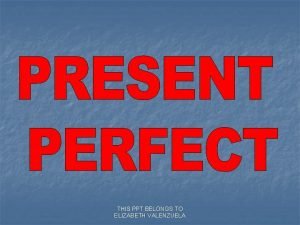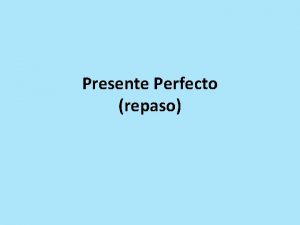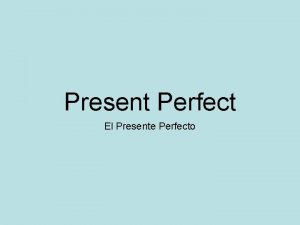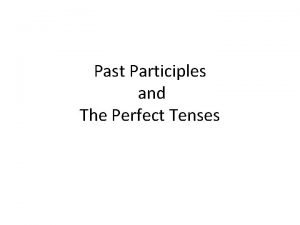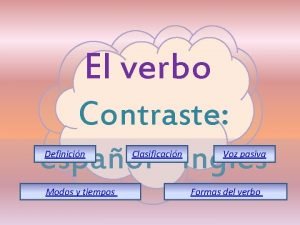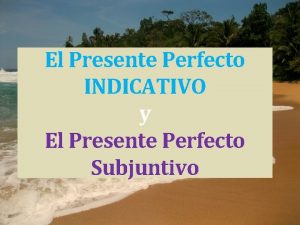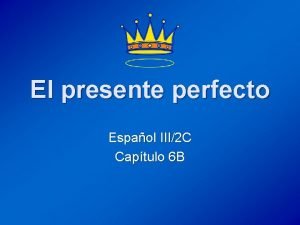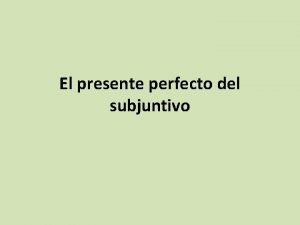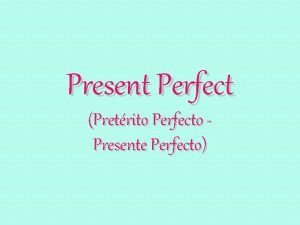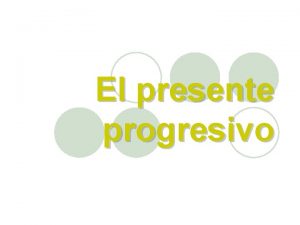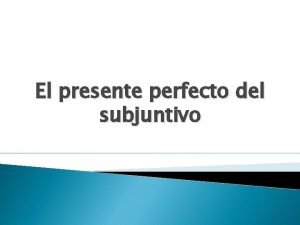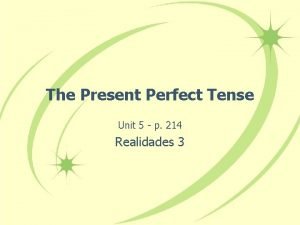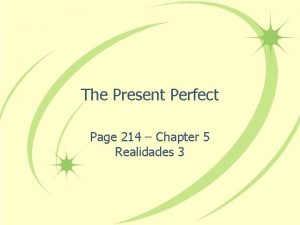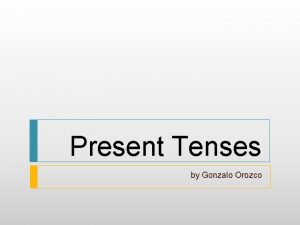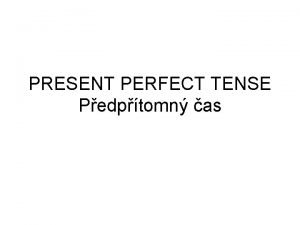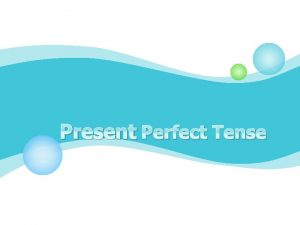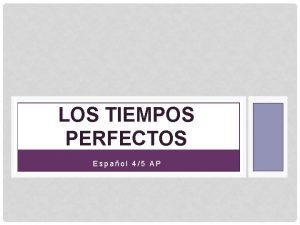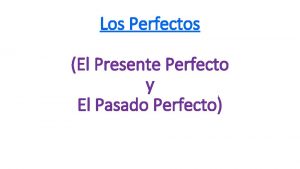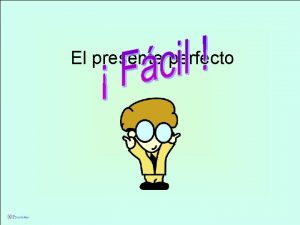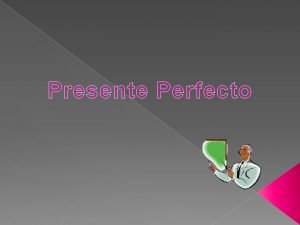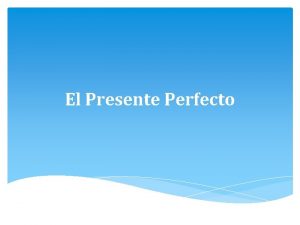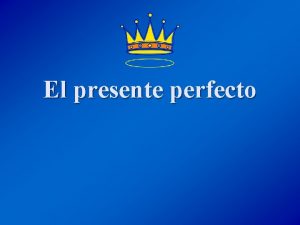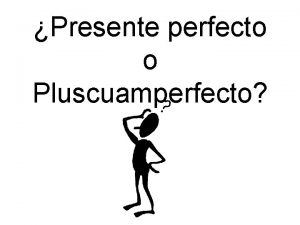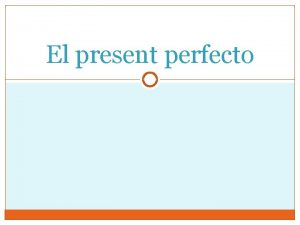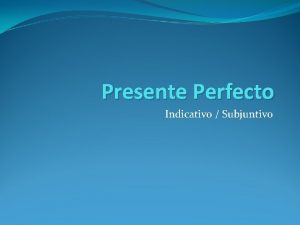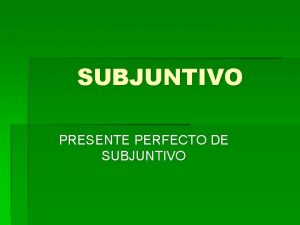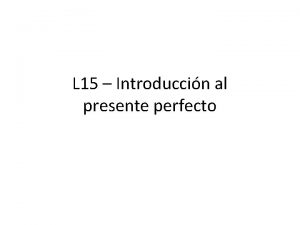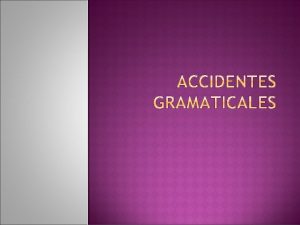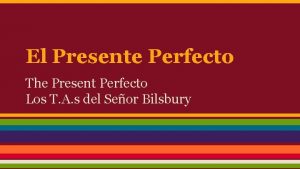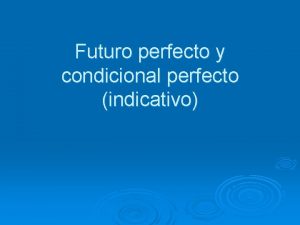Los Perfectos Parte 1 El Presente Perfecto Qu





















- Slides: 21

Los Perfectos Parte 1 El Presente Perfecto

¿Qué significa? I have spoken n They have drawn n

El Presente Perfecto All perfect verb tenses require two parts: HABER (conjugated)= To have n n n He Has Ha Hemos Habéis Han n n n I have You have He/She/It has We Have You all have They, You all have

…and a PAST PARTICIPLE Hablar n Comer n Dormir n Hablado n Comido n Dormido n – Spoken – Eaten – Slept Participles are VERB CONJUGATIONS; therefore they never change their endings to agree. A past participle is formed by removing the ending of the verb and adding -ADO or -IDO

¿Cómo? Una forma de haber es primero n un verbo en la forma de un participio es segundo Haber + verbo & ado / ido Yo he venido. Tú has buscado. And, although they may look funny, the following are regular forms: n n n Ido Sido

Just for your info… You’ve been using past participles for a long time, but as adjectives. n n Cansado- tired (cansar) Casado- married (casar) Divertido- fun (divertirse) Ocupado- busy (ocuparse) Adjective Past Participle Estoy cansada. I am tired. He cansado. I have tired.

All Together Now… He Has Ha Hemos Habéis Han bailar bailado ganar ganado divertir divertido ir ido comer comido beber bebido I have danced You have earned He/She has enjoyed We have gone You all have eaten They/You all have drank

Is there more? Of course there is. There always irregulars but let’s skip that for now and talk about when and how you use the… Present Perfect

So, when do you use it? Ejemplos: Has comido el desayuno? Have you eaten? No, todavía no he comido. No, I haven’t eaten yet. Ha llegado Jaime? Has James arrived? Sí, llegó hace una hora. Yes, he arrived an hour ago.

n n The Present Perfect is used to describe actions or events that have or have not happened. These actions and events began in the past and continue up to and into the present: Estudié mucho. I studied a lot. Implies that studying has stopped. He estudiado mucho. I have studied a lot. Implies that studying has not stopped.

Try these sentences (remember, it takes two words to form this verb tense): (click for answers) We haven’t skied this winter. No hemos esquiado este invierno. He has never learned to say no. Él nunca ha aprendido a decir no.

So, now for the irregulars… n n n n n Abrir Descubrir Escribir Ver Poner Volver Morir Romper Decir Hacer n n n n n Abierto Descubierto Escrito Visto Puesto Vuelto Muerto Roto Dicho Hecho

returned roto escrito put muerto descubierto written said opened hecho discovered puesto vuelto died broken visto done seen dicho abierto

A minor technicality… When you add –ado or –ido to a verb that ends in a double vowel, you will need to remember an accent: Oír- oído n Traer- traído Leer- leído Construir- construído

Last but not least…FAQ’s Q: What do you do when you have object pronouns like me, te, le, nos, les, los, las, se etc? A: That’s easy. Put them all IN FRONT of the verb group. Don’t ever place anything between the two or at the end. Example: ¿Te has divertido este año? Sí, me he divertido mucho. Q: Where do you put “no”? A: That’s easy too. Put it in front of the verb group. Don’t ever place anything between the two parts of the verb. Example: ¿Has visto la nueva película? No, no la he visto todavía. Q: What’s the difference between “tener”and “haber”? A: Tener is “to have”as in possession of something. Haber is an auxilary verb that is only used in conjunction with a past participle. Example: Paco tiene un coche rojo pero no ha aprendido a manejarlo. Paco has a red car but hasn’t learned how to drive it.

n n n Why haven’t you called him? ¿Por qué no lo has llamado? The Chargers haven’t won all year. Los Charges no han ganado este año. How many times have I told you? ¿Cuántas veces te he dicho?

La lección ha terminado. Uds. han aprendido muchísimo.

¡Ya tenemos que continuar a aprender más! n Página 64 n Caracas ha cambiado mucho. n n Mucha gente ha venido de fuera. n n Caracas has changed a lot. Many people have come from outside. La contaminación del aire ha empeorado bastante. n The contamination of the air has worsened quite a bit.

Puntos de vista… n Página 66 n Son buenos los adelantos tecnológicos pero ten en cuenta que la tecnología no lo resuelve todo. n …keep in mind that… n Me imagino que los adelantos nos ayudan mucho. n I imagine that… n Lo que noto es que ahora hay más estrés en la vida. n That which I notice is that…

Ya continuamos con los puntos de vista… n n n Me parece que los adelantos mejoran la calidad de nuestra vida. n It seems to me that… Se me hace que tenemos que usar el trasnporte público más. n It seems to me that… Lo que es importante es tener cuidado con la tecnología. n That which is important is + infinitive

Por fin… lo demás de las expresiones. n n Creo que vale la pena encontrar nuevas tecnologías. n I believe that it’s worth the pain (inconvenience) + infinitive… Es cierto que hay ventajas, pero por otro lado hay desventajas también. n It’s true that… but on the other hand…
 Yo no soy perfecto
Yo no soy perfecto Diferencias entre pasado simple y presente perfecto
Diferencias entre pasado simple y presente perfecto Entrevista en presente perfecto
Entrevista en presente perfecto Present perfect 1
Present perfect 1 Haber presente perfecto
Haber presente perfecto Qué significa voz pasiva y voz activa
Qué significa voz pasiva y voz activa Presente perfecto de indicativo
Presente perfecto de indicativo Try en presente perfecto
Try en presente perfecto Pretérito pluscuamperfecto
Pretérito pluscuamperfecto Conjunes
Conjunes Diferencia entre presente simple y pasado simple
Diferencia entre presente simple y pasado simple Presente perfecto pasivo
Presente perfecto pasivo Feel present simple
Feel present simple Uses of present perfect
Uses of present perfect Presente progresivo perfecto
Presente progresivo perfecto Estructura del presente perfecto
Estructura del presente perfecto El presente perfecto de subjuntivo
El presente perfecto de subjuntivo Revvmacphdd
Revvmacphdd Present perfect notice
Present perfect notice Present simple tense estructura
Present simple tense estructura Presente perfecto
Presente perfecto Ride present perfect
Ride present perfect

